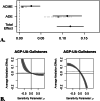Uric acid mediates the association of alpha-1 acid glycoprotein with gallstones in adult women in the United States
- PMID: 40760000
- PMCID: PMC12322271
- DOI: 10.1038/s41598-025-13208-8
Uric acid mediates the association of alpha-1 acid glycoprotein with gallstones in adult women in the United States
Abstract
Gallstones are a common biliary disorder whose pathogenesis may involve alpha-1-acid glycoprotein (AGP), an acute phase inflammatory protein. Serum uric acid (SUA) is the end product of purine metabolism and is associated with a variety of chronic diseases. We conducted a cross-sectional analysis of 1,652 adult women from the 2017-2020 NHANES database to explore the association between AGP levels and gallstone risk and the potential mediating role of SUA. We used multivariate logistic regression, restricted cubic spline curves, subgroup analyses, and causal mediation analyses to evaluate the association between serum AGP levels and gallstone risk.Serum AGP levels were significantly associated with gallstone risk. After correcting for covariates, the highest AGP quartile (≥ 0.950 g/L) was associated with a 1.72-fold higher risk of gallstones compared to the lowest quartile (≤ 0.629 g/L) (OR = 2.72,95% CI: 1.31-5.65; p = 0.014). Subgroup analyses revealed stronger associations in non-Hispanic whites, low-income individuals, and smokers. SUA partially mediated the AGP-gallstone relationship, accounting for 14.76% of the total effect. This study found that AGP levels were significantly associated with gallstone risk in US adult women, and serum uric acid played a mediating role. Future research should further investigate the causal relationship and its applicability in different populations.
Keywords: Alpha-1-acid glycoprotein; Cross-sectional study; Gallstones; Intermediary effect; Uric acid.
© 2025. The Author(s).
Conflict of interest statement
Declarations. Competing interests: The authors declare no competing interests. Ethics approval and consent to participate: The NHANES data utilised in this study is available to the public.The study does not require ethical approval.
Figures





Similar articles
-
The association between serum uric acid to creatinine ratio and gallstones: National Health and Nutrition Examination Survey 2017-2020.Sci Prog. 2025 Apr-Jun;108(2):368504251353326. doi: 10.1177/00368504251353326. Epub 2025 Jun 25. Sci Prog. 2025. PMID: 40560116 Free PMC article.
-
Association between alpha-1-acid glycoprotein and frailty in US females aged 20-49 years: analysis of NHANES data (2015-2023).Sci Rep. 2025 Jul 22;15(1):26534. doi: 10.1038/s41598-025-12188-z. Sci Rep. 2025. PMID: 40691261 Free PMC article.
-
The mediating role of inflammatory factors in the relationship between obesity and gallstone disease: evidence from the NHANES 2017-2020.Eur J Med Res. 2025 Jul 21;30(1):650. doi: 10.1186/s40001-025-02915-7. Eur J Med Res. 2025. PMID: 40685353 Free PMC article.
-
Modified dietary fat intake for treatment of gallstone disease in people of any age.Cochrane Database Syst Rev. 2024 Feb 6;2(2):CD012608. doi: 10.1002/14651858.CD012608.pub3. Cochrane Database Syst Rev. 2024. PMID: 38318932 Free PMC article.
-
Systemic pharmacological treatments for chronic plaque psoriasis: a network meta-analysis.Cochrane Database Syst Rev. 2021 Apr 19;4(4):CD011535. doi: 10.1002/14651858.CD011535.pub4. Cochrane Database Syst Rev. 2021. Update in: Cochrane Database Syst Rev. 2022 May 23;5:CD011535. doi: 10.1002/14651858.CD011535.pub5. PMID: 33871055 Free PMC article. Updated.
References
-
- Lammert, F. et al. Gallstones. Nat. Rev. Dis. Primers. 2, 16024 (2016). - PubMed
-
- Wang, X. et al. Global epidemiology of gallstones in the 21st century: A systematic review and Meta-Analysis. Clin. Gastroenterol. Hepatol.22, 1586–1595 (2024). - PubMed
-
- Everhart, J. E., Khare, M., Hill, M. & Maurer, K. R. Prevalence and ethnic differences in gallbladder disease in the united States. Gastroenterology117, 632–639 (1999). - PubMed
MeSH terms
Substances
LinkOut - more resources
Full Text Sources

